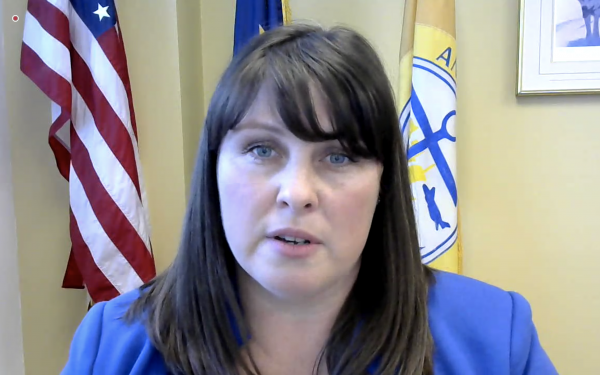
Acting Anchorage Mayor Austin Quinn-Davidson announced Friday the city will expand masking rules and restrict gathering sizes to combat a record-breaking surge in COVID-19 cases. Quinn-Davidson said the city is hiring three officers to assist businesses with enforcing the restrictions. The officers will respond to complaints of non-compliance and perform spot checks, she said.
The new orders go into effect Monday at 8 a.m.
The first change is an update to the municipality’s existing mask order, removing most exceptions to the requirement, which the administration says will make it easier to enforce.
The update says:
- Individuals who cannot wear masks for medical reasons or a disability are required to wear face shields instead.
- Children over five will now be included in the mask order, unless they’re at a preschool program. Previously, children under 12 were exempt from the order unless a parent or caregiver was present to supervise mask use.
- People exercising indoors must now wear masks.
A second change further restricts gathering sizes:
- Indoor gatherings will be limited to 10 people if there is food or drinks and 15 people if there isn’t.
- Outdoor gatherings with food or drinks are limited to 20 people, and 30 people without.
The municipality has also limited classroom capacity at public and private schools to 50%. The capacity restriction is based on fire code capacity, according to the municipality.
“The order does not require class sizes to be cut in half. The metric is not how many kids normally are assigned to be in the classroom, but rather how big is the classroom space,” according to an email from city spokeswoman Carolyn Hall.
Quinn-Davidson said the municipality worked with the Anchorage School District on the new restriction. ASD spokesman Alan Brown said in an email that it will not impede the district’s current plan to bring younger students back into buildings on Nov. 16. Brown said elementary classroom capacities vary, but generally based on fire and building code, they’re roughly 45 to 50 people.
It’s less clear what the new rules will mean for private schools. Several leaders of private schools where in-person learning is ongoing said they just learned about the new restrictions Friday afternoon, and were still trying to figure them out.
“We had no advanced warning,” said Randy Karlberg, superintendent of Grace Christian School. “We have to look into it.”
Capacity restrictions at places of worship or political expression, restaurants, theaters and bingo halls are still limited to 50 percent.
Chris Anderson, president of Glacier Brewhouse in downtown, said the emergency orders should be just like any other regulation that businesses comply with.
“We have health regulations … We have liquor regulations … we have building code regulations, where we have checks, we have tons of these regulations,” he said. “I think it’s time to enforce because what we’re all trying to do is stay in business and have a healthy community.”
Quinn-Davidson emphasized that the mandates are meant to keep Anchorage’s economy afloat by keeping businesses open while also trying to mitigate the spread of the coronavirus.
“When COVID numbers are high, people don’t want to get sick, and they don’t want to get their loved ones sick. So they start pulling back from supporting the local economy,” she said. “We must get our COVID numbers under control now to save lives and to support our businesses.
Last week, the administration and Anchorage Health Department issued a warning to the residents to take masking and social distancing seriously as the 14-day case average rose to 40 per 100,000 residents, well above the state’s cutoff for high risk, which is 10 per 100,000.
This week the 14-day average even rose further to 60 infections per 100,000 people.
“We’re hearing from hospital CEOs who are concerned that the spike in cases will threaten their ability to staff critical care beds,” Quinn-Davidson said. “If that happens, it’s not just COVID-19 patients that wouldn’t receive care. Anyone in our community could be turned away.”
She added that if the community doesn’t see a sufficient decline in case numbers within a few weeks, Anchorage is headed for “significant restrictions.”
Alaska Public Media’s Tegan Hanlon contributed to this report.
Kavitha George is Alaska Public Media’s climate change reporter. Reach her at kgeorge@alaskapublic.org. Read more about Kavitha here.





